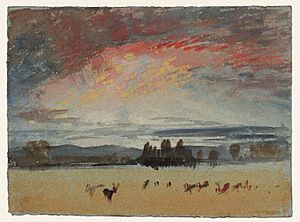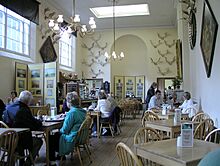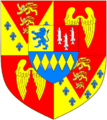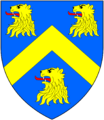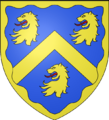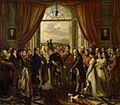Petworth House facts for kids
Quick facts for kids Petworth House |
|
|---|---|
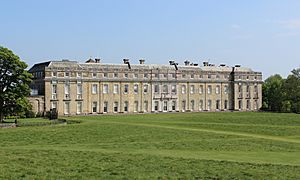
Petworth House, west façade
|
|
| Type | Country house, Baroque |
| Location | Petworth, West Sussex |
| OS grid reference | SU975218 |
| Built | 1688 |
| Owner | National Trust |
|
Listed Building – Grade I
|
|
| Designated | 1 June 1984 |
| Reference no. | 1000162 |
Petworth House is a grand country house in West Sussex, England. It is famous for its amazing art collection and a huge park full of deer. The main part of the house was built in 1688 in the Baroque style, which is known for being grand and impressive.
For many centuries, Petworth was the southern home of the powerful Percy family. Today, it is cared for by the National Trust, a charity that protects historic places. The house is well-known for its collection of paintings, including many by the famous artist J. M. W. Turner. The park was designed by the celebrated landscape artist Capability Brown.
Contents
History of the House
A Royal Gift and a Family Home
The story of Petworth begins when Adeliza of Louvain, the widow of King Henry I, gave the land to her brother, Joscelin of Louvain. He married a woman from the wealthy Percy family and took her last name. The Percys were one of the most powerful families in northern England, and their main home was Alnwick Castle. Petworth was meant to be a place for them to stay when they were in the south.
The first house on the site was a fortified manor built around 1309. Parts of its chapel and basement still exist inside the house today.
During the 1500s, the Percy family, who were Catholic, had disagreements with the Protestant rulers of England. King Henry VIII even took the house away from them for a while. Later, during the reign of Queen Elizabeth I, the family was involved in a plot against her. As a punishment, the family was told they had to stay at Petworth, where the royal court could keep an eye on them. Because of this, they turned Petworth into their permanent home, adding stables and beautiful gardens.
The Grand Rebuilding
In 1682, the Percy family's vast fortune was inherited by Lady Elizabeth Percy. She married Charles Seymour, 6th Duke of Somerset, and they became one of the richest couples in England.
The Duke, who was nicknamed 'the Proud Duke', wanted a home that could compete with the grand palaces of Europe, like the Palace of Versailles in France. Between 1688 and 1702, he and his wife rebuilt Petworth House in the fashionable Baroque style, which loved symmetry and fancy details. They also created formal gardens with lime tree avenues, ponds, and a greenhouse.
A New Family and a New Park
In 1750, the house passed to a new family, the Wyndhams. The new owner, Charles Wyndham, hired the famous landscape designer Lancelot 'Capability' Brown in the 1750s.
Brown completely changed the park's look. He removed the formal gardens and created a more natural-looking landscape of rolling hills, gentle slopes, and scattered trees. This is the beautiful park we see today, and it is considered one of his greatest works.
A House of Art
The house became a true treasure chest of art under George Wyndham, 3rd Earl of Egremont. He was a great supporter of artists and collected many paintings and sculptures. He even added a special North Gallery to the house between 1824 and 1825 just to show off his collection.
His favourite artist was J. M. W. Turner, who often stayed at Petworth. Turner painted many pictures of the house and its park. The artist John Constable was also a frequent visitor.
Becoming a National Treasure
In 1947, the Wyndham family gave Petworth House and its deer park to the nation. It is now managed by the National Trust. This means everyone can visit and enjoy this special place. The family, now known as Lord and Lady Egremont, still lives in a private part of the house, continuing a long tradition of occupancy.
The Art Collection
Petworth is home to one of the finest art collections in the care of the National Trust. Visitors can see many amazing works.
- Paintings: There are 20 paintings by J. M. W. Turner, as well as works by famous artists like Anthony van Dyck and Joshua Reynolds.
- Carvings: The house features incredibly detailed wood carvings by Grinling Gibbons.
- Sculptures: There is a large collection of ancient Roman and Greek statues, as well as newer sculptures.
- Painted Ceilings: Some rooms have huge, colourful paintings on the ceilings by Louis Laguerre.
- A Rare Globe: Petworth has a globe made by Emery Molyneux in 1592. It is believed to be the only one of its kind left in the world.
Petworth Park and Gardens
The park surrounding the house covers 700 acres. It was designed by Capability Brown to look like a natural landscape painting. A large herd of fallow deer roams freely in the park.
Next to the house is a smaller woodland garden called the Pleasure Ground. The park and gardens are so important that they are listed as Grade I on the Register of Historic Parks and Gardens. The park is also a popular spot for cricket.
Visiting Petworth Today
Petworth House is a popular place to visit. The National Trust provides facilities for visitors, including a car park, a shop, a café in the historic Audit Room, and a second-hand bookshop.
Inside the house, you can explore the grand rooms and see the art collection up close. In the nearby town of Petworth, you can also visit the Petworth Cottage Museum, which shows what life was like for workers on the estate around the year 1910.
Petworth in the Movies
Because of its stunning beauty, Petworth House has often been used as a filming location for movies and TV shows. You might recognize it from films like:
- Elizabeth: The Golden Age (2007)
- Maleficent (2014)
- Mr Turner (2014), a film about the artist J. M. W. Turner
- Rebecca (2020)
- Bridgerton (2022)
- Napoleon (2023)
Images for kids


